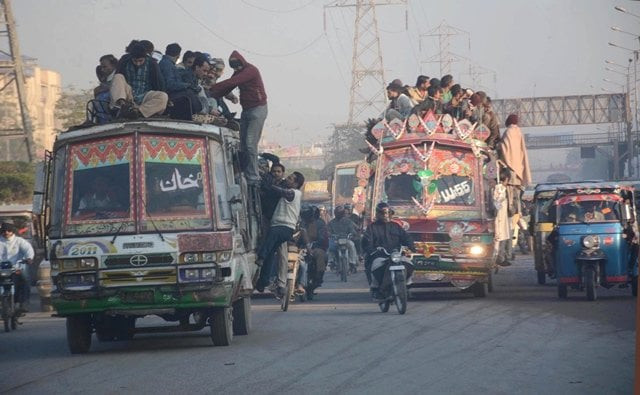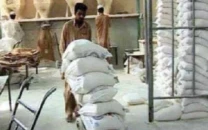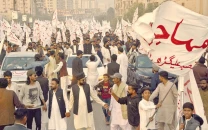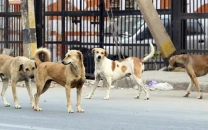The wheels of Karachi’s buses grind to a halt
No proper public transport system for Pakistan’s financial hub

Due to the chronic lack of public transport passengers are often forced to climb atop buses. PHOTO: FILE
Many have been forced to climb onto the roofs of dilapidated buses to get to work. It is a common sight to see people hanging off the sides of buses, heading to their destinations in great discomfort.
This situation leaves them prone to accidents and puts their lives at considerable risk. Due to a shortage of buses, even women and female students have been facing severe difficulties.
Rickshaw and taxi drivers capitalise on this situation to charge fares of their own choice. The city has witnessed the closure of 269 public transport routes. Adding to the citizens’ misery, more than 10,000 vehicles have been scrapped, converted into loading trucks and contract carrier buses or moved out of the city.
For the past many years, no new bus scheme has been introduced in the city. According to an estimate, there are only 4,500 public transport vehicles plying on the city’s roads. However, the provincial transport and mass transit department claims there are 6,176 buses, mini buses and coaches operating on 165 routes in Karachi.
PDMA to print messages on public transport
With a population of more than 20 million people, the city desperately requires 8,000 large buses to provide reasonable transport facilities to its residents.
The federal and provincial governments have failed to improve the transport system and add new buses in the financial hub of Pakistan, which provides 70% of the nation's revenue. For the past three decades, the poor law and order situation in the city along with frequent strikes and protests during which transport vehicles were burnt have taken its toll on the transport system. These factors along with the CNG crisis, arrival of illegal qingqi rickshaws and other issues have all contributed towards the declining number of buses, mini buses and coaches in the port city.
Of the 6,176 buses, mini buses, and coaches the provincial government claims are operating in Karachi, 653 are large buses, 2,926 mini buses and 2,391 coaches. Under the auspices of the Karachi transport society, 160 buses are operating, while the urban transport scheme has 10 buses under its banner. An additional 36 CNG buses are operating under the Karachi Metropolitan Corporation.
A survey conducted by Express News showed that the provincial government’s statistics were skewed. The city has around 4,500 buses, mini buses and coaches plying on its roads. Many transporters have been issued route permits but their vehicles are non-functional.
SHC orders concessionary transport fares for students
Owing to a loss in business or for other reasons, they are operating vehicles outside the city or have converted them into loading trucks or contract carrier buses. Transporters try to obtain route permits so that they can establish their hegemony over these routes and also get the chance to bring their vehicles back if they desire. No survey conducted by the Sindh government on this issue could be found. The data has been collected based on registration and route permits.
The Express News survey has revealed that the transport system is on the brink of ruin. There is a mass transit system with large buses in all the major cities of the world. At one time, the city of Karachi, under the supervision of the tramway system, circular railway and Karachi Transport Corporation was providing standard and cost-effective traveling services but this has now been replaced with 50-year-old public transport vehicles plying on dilapidated roads.
From 1970 onwards, the authority of the government over the public transport system started to diminish. After that, the elite officers of both the civilian and military governments played roles in the ruin of the transport system. The tramway met its end due to its sluggish operations and the increase of vehicles on the road but the termination of the Karachi Circular Railway and Karachi Transport Corporation was the result of corruption and negligence of officials.
The tramway saw its demise in 1975 while the circular railway and Karachi Transport Corporation ceased functioning in 1999 and 1997 respectively.
Blue Line BRT to be environmentally assessed
According to records of the regional transport authority, there were 60 bus routes in the city of which 30 routes have been closed in the past 15 years, leaving only 30 routes operational. Mini buses had 236 routes of which 137 have been shut down and only 87 remain in operation. Coaches had 75 routes of which only 40 are operational while the rest have been shut down.
Only seven of the 53 routes of the Karachi public transport society remain operational. The urban transport scheme has witnessed a sharp decline with only one operational route out of its former 22 routes. Overall, out of the 446 routes of public transport in the city, 269 routes have been closed.
Some of the well-known routes of large buses that have been closed include 8D, 1C, 5, 5D, 5E, 11A, 1F, 72, 72A, 5A, 5B, 4M, 4H, and 6B. Some of the routes of mini buses that have been closed are A, A1, A2, B1, D2, F3, F4, G, G1, K, K1, M, M3, N2, N3, P2, P6, S, S1, U2 and U3. Among the coaches that are no longer functional are the Mehfooz coach, Umar coach, National Pakhtoon coach and New Ghazi coach.
According to transporters, this business requires a lot of guts as in the past, numerous transport vehicles have been burned down during strikes. Nevertheless, the transporters somehow managed to continue with business one way or the other. However, with the arrival of the motorcycle Qingqi and CNG Qingqi rickshaw services that seat between nine and 12 passengers, the backbone of the transport system has broken. During this time, many large buses were scrapped and mini buses were either converted to loading trucks or carrier buses.
SBBWU adds three mini buses to its fleet
Owing to the Qingqi rickshaw services, the number of public transport vehicles was reduced to 4,500. The high court's decision to ban this illegal business in 2015 put forth some glimmer of hope and public transport managed to resurrect itself to a certain extent. Some of the closed routes were opened once again and the vehicles returned too. However, the overall situation is still in dire need of attention.
Due to the indifference of the federal and provincial governments towards the transport system, the city government's urban transport scheme introduced in 2004 failed. Under this scheme, 250 new large buses were introduced but, due to various reasons including lack of subsidies and terminals, the scheme came to an end.
Now the city only has 10 buses functioning on the UTS-12 route. The former city government, under a second scheme introduced in 2009, initiated the operations of 75 new CNG buses on two different routes. For some time, these vehicles were managed efficiently but later this scheme was also closed down due to lack of funds and political interference. Four buses of this scheme were donated to the Karachi Medical and Dental College and two to the National Institute of Management. Another two vehicles were burnt.
BRT firm gets top bosses
Only 36 buses in working condition are operating from Gulshan-e-Hadeed to Tower, while the remaining 31 non-functional buses stand useless at the Surjani depot.
According to sources, the federal government took notice of the lack of public transport in Karachi in 2009 and allocated Rs2.5 billion for the introduction of 4,000 CNG buses. This project was supposed to be implemented on the basis of public-private partnership. The transporters were supposed to invest 20% in the project while the remaining 80% was to be provided by banks in the form of loans.
An advance payment of Rs300,000 and subsidy on the loan interest were supposed to be paid to the transporters from the allocated government funds. The federal government had also paid the first installment of Rs300 million to the State Bank. However, the private banks refused to provide loans to the transporters. Later, due to lack of interest from the federal and provincial governments, the project never materialised.
Different studies of the Karachi mass transit system have concluded that as many as 70,000 passengers utilise the public transport in Karachi on a daily basis. However, due to a severe shortage of vehicles, the public is forced to travel on the roofs of these vehicles.



















COMMENTS
Comments are moderated and generally will be posted if they are on-topic and not abusive.
For more information, please see our Comments FAQ